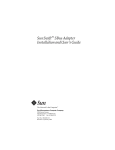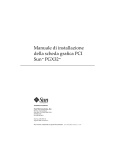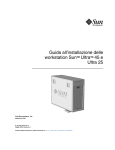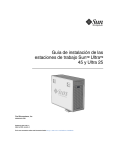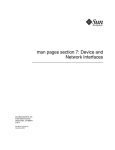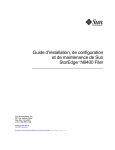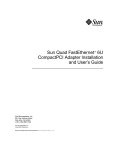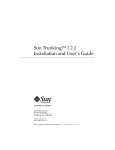Download Sun™ Quad FastEthernet™ PCI Adapter Release Notes
Transcript
Sun™ Quad FastEthernet™ PCI Adapter Release Notes Sun Microsystems, Inc. 901 San Antonio Road Palo Alto, CA 94303-4900 USA 650 960-1300 Fax 650 969-9131 Part No. 805-2901-12 July 1998, Revision A Send comments about this document to: [email protected] Copyright 1998 Sun Microsystems, Inc., 901 San Antonio Road • Palo Alto, CA 94303 USA. All rights reserved. This product or document is protected by copyright and distributed under licenses restricting its use, copying, distribution, and decompilation. No part of this product or document may be reproduced in any form by any means without prior written authorization of Sun and its licensors, if any. Third-party software, including font technology, is copyrighted and licensed from Sun suppliers. Parts of the product may be derived from Berkeley BSD systems, licensed from the University of California. UNIX is a registered trademark in the U.S. and other countries, exclusively licensed through X/Open Company, Ltd. Sun, Sun Microsystems, the Sun logo, AnswerBook, Java, the Java Coffee Cup, Sun Quad FastEthernet, Sun Trunking, SunSolve, SunService, and Solaris are trademarks, registered trademarks, or service marks of Sun Microsystems, Inc. in the U.S. and other countries. All SPARC trademarks are used under license and are trademarks or registered trademarks of SPARC International, Inc. in the U.S. and other countries. Products bearing SPARC trademarks are based upon an architecture developed by Sun Microsystems, Inc. The OPEN LOOK and Sun™ Graphical User Interface was developed by Sun Microsystems, Inc. for its users and licensees. Sun acknowledges the pioneering efforts of Xerox in researching and developing the concept of visual or graphical user interfaces for the computer industry. Sun holds a non-exclusive license from Xerox to the Xerox Graphical User Interface, which license also covers Sun’s licensees who implement OPEN LOOK GUIs and otherwise comply with Sun’s written license agreements. RESTRICTED RIGHTS: Use, duplication, or disclosure by the U.S. Government is subject to restrictions of FAR 52.227-14(g)(2)(6/87) and FAR 52.227-19(6/87), or DFAR 252.227-7015(b)(6/95) and DFAR 227.7202-3(a). DOCUMENTATION IS PROVIDED “AS IS” AND ALL EXPRESS OR IMPLIED CONDITIONS, REPRESENTATIONS AND WARRANTIES, INCLUDING ANY IMPLIED WARRANTY OF MERCHANTABILITY, FITNESS FOR A PARTICULAR PURPOSE OR NONINFRINGEMENT, ARE DISCLAIMED, EXCEPT TO THE EXTENT THAT SUCH DISCLAIMERS ARE HELD TO BE LEGALLY INVALID. Copyright 1998 Sun Microsystems, Inc., 901 San Antonio Road • Palo Alto, CA 94303 Etats-Unis. Tous droits réservés. Ce produit ou document est protégé par un copyright et distribué avec des licences qui en restreignent l’utilisation, la copie, la distribution, et la décompilation. Aucune partie de ce produit ou document ne peut être reproduite sous aucune forme, par quelque moyen que ce soit, sans l’autorisation préalable et écrite de Sun et de ses bailleurs de licence, s’il y en a. Le logiciel détenu par des tiers, et qui comprend la technologie relative aux polices de caractères, est protégé par un copyright et licencié par des fournisseurs de Sun. Des parties de ce produit pourront être dérivées des systèmes Berkeley BSD licenciés par l’Université de Californie. UNIX est une marque déposée aux Etats-Unis et dans d’autres pays et licenciée exclusivement par X/Open Company, Ltd. Sun, Sun Microsystems, le logo Sun, AnswerBook, Java, le logo Jave Coffee Cup, Sun Quad FastEthernet, Sun Trunking, SunSolve, SunService, et Solaris sont des marques de fabrique ou des marques déposées, ou marques de service, de Sun Microsystems, Inc. aux Etats-Unis et dans d’autres pays. Toutes les marques SPARC sont utilisées sous licence et sont des marques de fabrique ou des marques déposées de SPARC International, Inc. aux Etats-Unis et dans d’autres pays. Les produits portant les marques SPARC sont basés sur une architecture développée par Sun Microsystems, Inc. L’interface d’utilisation graphique OPEN LOOK et Sun™ a été développée par Sun Microsystems, Inc. pour ses utilisateurs et licenciés. Sun reconnaît les efforts de pionniers de Xerox pour la recherche et le développement du concept des interfaces d’utilisation visuelle ou graphique pour l’industrie de l’informatique. Sun détient une licence non exclusive de Xerox sur l’interface d’utilisation graphique Xerox, cette licence couvrant également les licenciés de Sun qui mettent en place l’interface d’utilisation graphique OPEN LOOK et qui en outre se conforment aux licences écrites de Sun. CETTE PUBLICATION EST FOURNIE "EN L’ETAT" ET AUCUNE GARANTIE, EXPRESSE OU IMPLICITE, N’EST ACCORDEE, Y COMPRIS DES GARANTIES CONCERNANT LA VALEUR MARCHANDE, L’APTITUDE DE LA PUBLICATION A REPONDRE A UNE UTILISATION PARTICULIERE, OU LE FAIT QU’ELLE NE SOIT PAS CONTREFAISANTE DE PRODUIT DE TIERS. CE DENI DE GARANTIE NE S’APPLIQUERAIT PAS, DANS LA MESURE OU IL SERAIT TENU JURIDIQUEMENT NUL ET NON AVENU. Please Recycle Sun Quad FastEthernet PCI Adapter Release Notes This document contains the following important information about the Sun™ Quad FastEthernet™ PCI Adapter and the Sun Quad FastEthernet 2.1 driver software: ■ ■ ■ ■ ■ ■ ■ ■ ■ “Required Software Patches” on page 2 “Conflicts With FastEthernet Switches (100BASE-T)” on page 5 “Increasing Performance on Enterprise Servers with Four Quad FastEthernet Adapters” on page 5 “Increasing Synchronized Queues to Improve Network Performance” on page 6 “Disabling IP Forwarding Routing Protocols on Application Servers” on page 6 “Increasing TCP/IP Performance on Solaris 2.6 Systems” on page 7 “Editing the driver_aliases File on Solaris 2.5.1 Systems” on page 8 “Avoiding a System Panic While Detaching a PCI Networking Device” on page 9 “Known Problems With the Installation and User’s Guide” on page 9 Note – If your system is running the Solaris™ 2.6 Hardware: 5/98 operating environment, or subsequent compatible versions, do not use the driver on the Sun Quad FastEthernet 2.1 CD-ROM. The software on the Solaris CD-ROM is more current and replaces previous versions of the driver. For information on this version of the driver, refer to the Platform Notes: The Sun Quad FastEthernet Device Driver, which is shipped with the Solaris documentation. For information on patches, see “Sun Quad FastEthernet 2.2 Software Patches” on page 4. Caution – To avoid a system panic, you must follow the hardware and software installation procedures in the Sun Quad FastEthernet PCI Adapter Installation and User’s Guide (805-1797-10) and these release notes. 1 Required Software Patches To achieve the best performance from the Sun Quad FastEthernet driver software, you must install a patch. Before installing a patch or the software from the Sun Quad FastEthernet 2.1 CD-ROM, check to see if there is already another version of the Sun Quad FastEthernet driver on your system. Checking for Installed Sun Quad FastEthernet Software Previous versions of the Sun Quad FastEthernet driver have been included with other Sun products. Before installing the Sun Quad FastEthernet 2.1 software, check your system for other versions of the Sun Quad FastEthernet driver. Bundled Sun Quad FastEthernet Drivers Beginning with the Solaris 2.6 Hardware: 5/98 release, the Sun Quad FastEthernet driver is bundled with the Solaris operating environment. This version of the Sun Quad FastEthernet driver is more current than the one shipped on the Sun Quad FastEthernet 2.1 CD-ROM. Note – If your system is running the Solaris 2.6 Hardware: 5/98 environment, or future compatible Solaris releases, do not install the software from the Sun Quad FastEthernet 2.1 CD-ROM. If your system is running the Solaris 2.6 operating environment, and you are unsure if it is running the Hardware: 5/98 release, check the contents of the /etc/release file. % cat /etc/release Solaris 2.6 5/98 build_id_name SPARC Copyright 1998 Sun Microsystems, Inc. All Rights Reserved. Assembled on 24 April 1998 If this file exists, and it contains Solaris 2.6 5/98, your system is running the Solaris 2.6 Hardware: 5/98 release. See “Installing the Required Quad FastEthernet Software Patches” on page 4 for patch information. 2 Sun Quad FastEthernet PCI Adapter Release Notes • July 1998 Checking for Quad FastEthernet Software Shipped With Other Products Other versions of the Sun Quad FastEthernet software have been shipped with an earlier release of the adapter and with the Sun Trunking™ software. ● To check your system for installed Sun Quad FastEthernet software, type the following at a command prompt: % pkginfo -x SUNWqfed SUNWqfed Sun Quad FastEthernet Adapter Driver (sparc) 3.0 Use the table below to translate the pkginfo output. TABLE 1 pkginfo Output Description pkginfo -x Output Description and Action No output Your system does not have the Sun Quad FastEthernet software installed. Follow the installation instructions in the Sun Quad FastEthernet 2.1 CD Insert, and then install the patch listed in “Installing the Required Quad FastEthernet Software Patches” on page 4. 1.0 Your system has the Sun Quad FastEthernet 2.0 software installed. You must remove this 2.0 version of the software and install the 2.1 software as described in the Sun Quad FastEthernet 2.1 CD Insert. After installing the software, install the patch listed in “Installing the Required Quad FastEthernet Software Patches” on page 4. 1.1 Your system already has the Sun Quad FastEthernet 2.1 software installed. Install the patch listed in “Installing the Required Quad FastEthernet Software Patches” on page 4. 3.0 Your system has the Sun Quad FastEthernet software installed with the Sun Trunking 1.0 software. Do not install the software from the CD-ROM and do not install any patch listed in these release notes. Note: If you remove this version of the software, you will not be able to use the Trunking 1.0 software. 3.1 Your system has the Sun Quad FastEthernet 2.2 software installed. This version was shipped with the Sun Trunking 1.0.1 software and the Solaris 2.6 Hardware: 5/98 software. Do not install the software from the CD-ROM, but do install the patch listed in “Installing the Required Quad FastEthernet Software Patches” on page 4. Sun Quad FastEthernet PCI Adapter Release Notes 3 Installing the Required Quad FastEthernet Software Patches Install the patch, listed below, that is appropriate for the version of the Sun Quad FastEthernet software and the Solaris environment installed on your system. These patches correct panics during dynamic reconfiguration, difficulties with certain FastEthernet switches, and problems with general network performance (refer to these patches’ README files for more information). Sun Quad FastEthernet 2.1 Software Patches This version of the Sun Quad FastEthernet software is shipped with the Sun Quad FastEthernet 2.1 CD-ROM. Install the software from this CD before installing the patch. TABLE 2 Sun Quad FastEthernet 2.1 Patches Operating Environment Patch Identification Number Solaris 2.5.1 Hardware: 4/97, 8/97, and 11/97 105532-x Solaris 2.6 (prior to Solaris 2.6 Hardware: 5/98) 105541-x Sun Quad FastEthernet 2.2 Software Patches This version of the Sun Quad FastEthernet software is shipped with the Sun Trunking 1.0.1 software and the Solaris 2.6 Hardware: 5/98 environment. TABLE 3 Sun Quad FastEthernet 2.2 Patches Operating Environment Patch Identification Number Solaris 2.5.1 Hardware: 4/97, 8/97, and 11/97 106531-x Solaris 2.6 Solaris 2.6 Hardware: 5/98 106532-x The patches listed above are current as of the printing of this document. Future revisions of these patches will also correct problems with this software. These patches may also be included in future jumbo kernel patches. 4 Sun Quad FastEthernet PCI Adapter Release Notes • July 1998 Note – For information on how to get the latest patches and patch revisions, visit the SunSolve™ website at http://sunsolve.sun.com. Otherwise, contact your local SunServiceSM representative for assistance or your local SunService authorized service provider for more information. Conflicts With FastEthernet Switches (100BASE-T) There are two FastEthernet (100BASE-T) switches that may present difficulties when working with the Sun Quad FastEthernet PCI adapter: ■ ■ Bay Networks model 28115/ADV SynOptics model 28115 If you use the adapter with these switches, you will encounter difficulties (refer to bug ID 4071199 for more information). Installing the Quad FastEthernet 2.1 driver patch, as described in “Installing the Required Quad FastEthernet Software Patches” on page 4, will fix these difficulties. Increasing Performance on Enterprise Servers with Four Quad FastEthernet Adapters If you have four Sun Quad FastEthernet adapters in an Enterprise server, you may experience slow performance and response times during periods of high network traffic. This poor performance is usually caused by applications that use data buffer and socket buffer sizes greater than 8 Kbytes. You can achieve better network performance by adjusting your application’s data buffer size and socket buffer size to be less than or equal to 8 Kbytes. Refer to the application’s documentation for instructions on how to set these buffer sizes. Sun Quad FastEthernet PCI Adapter Release Notes 5 Increasing Synchronized Queues to Improve Network Performance To increase the size of STREAMS synchronized queues, thereby increasing network performance, add the sq_max_size variable to the /etc/system file. set sq_max_size=n Set the sq_max_size variable to n, where n is the maximum number of messages that are allowed for each IP queue. A safe value to set this variable is 25 for each 64 Mbytes of RAM in the system. For example, if your system has 64 Mbytes of RAM, you would set the variable to 25 (50 if the system has 128 Mbytes of RAM, 100 if your system has 256 Mbytes of RAM, and so on). You can be more aggressive if you choose, but you may overrun STREAMS resources. Refer to the Solaris documentation for more information. Disabling IP Forwarding Routing Protocols on Application Servers By default, the Solaris operating environment will configure systems using more than one network interface to be an IP forwarding router. Application servers are typically multihomed, which mean that they contain more than one network interface but do not run IP routing protocols or forward IP packets. If you do not disable the IP forwarding and routing protocols on multihomed application servers, the servers may experience poor performance. NFS servers and database servers are a couple of examples of multihomed application servers. The purpose of these application servers is to provide a presence on multiple networks. These networks usually contain dedicated routing devices (routers, layer-3 switches, or dedicated Sun systems) in the network infrastructure that provide the IP forwarding routing services. 6 Sun Quad FastEthernet PCI Adapter Release Notes • July 1998 To maximize the performance of your multihomed desktop or application server, we recommend disabling the IP forwarding and routing protocols. One method of disabling IP forwarding is to create an /etc/notrouter file and then reboot your system. 1. As superuser, type: # /usr/bin/touch /etc/notrouter 2. Shut down and reboot the system. 3. After rebooting your system, verify that IP forwarding has been disabled in the kernel. # /usr/sbin/ndd /dev/ip ip_forwarding If you receive a 0 result, your system will never forward IP packets. If you receive non-zero result, your system may still forward IP packets. If you received non-zero result, your system may contain an /etc/defaultrouter file. The existence of this file may prevent the /etc/init.d/inetinit boot script from detecting the /etc/notrouter file. You may want to remove the /etc/defaultrouter file or, alternatively, force the ndd parameter, ip_forwarding, to equal 0. For more information, refer to the TCP/IP and Data Communications Administration Guide shipped with the Solaris documentation. Increasing TCP/IP Performance on Solaris 2.6 Systems If you are running your Solaris 2.6 system with a large TCP window, and you experience slowdowns during periods of high network traffic, you should decrease the TCP default maximum retransmission timeout interval variable (tcp_rexmit_interval_max) to 60000. ● As superuser type: # ndd -set /dev/tcp tcp_rexmit_interval_max 60000 Sun Quad FastEthernet PCI Adapter Release Notes 7 The changes are immediate, and they affect all the TCP connections in the system. However, the changes will be lost when you reboot your machine. Note – You may not need to perform this workaround if you use a smaller TCP window (for example, an 8 Kbyte or a 16 Kbyte window). To avoid losing the TCP/IP setting, you can put the parameter change in a run control script in the /etc/rc2.d directory, similar to the following example. #!/sbin/sh # Local kernel modifications # case "$1" in 'start') echo "Setting local kernel parameters...\c" ndd -set /dev/tcp tcp_rexmit_interval_max 60000 echo "" ;; 'stop') echo "No kernel parameters changed." ;; *) echo "Usage: $0 {start|stop}" ;; esac exit 0 Editing the driver_aliases File on Solaris 2.5.1 Systems If your system is running the Solaris 2.5.1 operating environment, versions: Hardware: 4/97, Hardware: 8/97, or Hardware: 11/97, you must add the pci_pci "pci1011,25" line to your /etc/driver_aliases file before installing the adapter. Refer to page 5 of the Sun Quad FastEthernet PCI Installation and User’s Guide for instructions on editing the driver_aliases file. 8 Sun Quad FastEthernet PCI Adapter Release Notes • July 1998 Avoiding a System Panic While Detaching a PCI Networking Device Unloading or detaching a PCI networking device may cause a Solaris 2.5.1 system to crash because of a problem with the PCI (4) nexus driver. Refer to bug ID 4058070 for more information. Install the 105004-10 patch to fix this bug. This patch is current as of the printing of this document. Future revisions of this patch will also correct the problems described in the 4058070 bug report. This patch may also be included in future jumbo kernel patches. Note – For information on how to get the latest patches and patch revisions, visit the SunSolve website at http://sunsolve.sun.com. Otherwise, contact your local SunService representative for assistance or your local SunService authorized service provider for more information. Known Problems With the Installation and User’s Guide Configuring the Host Files Note – “Configuring the Host Files” on page 11 of the Sun Quad FastEthernet PCI Adapter Installation and User’s Guide contains inaccurate qfe interface numbers and hostname.qfe<num> file names. The corrected section is shown below. After installing the Sun Quad FastEthernet driver software, you must create a hostname.qfe<num> file for the adapter’s Ethernet interfaces. You must also create both an IP address and a host name for its Ethernet interfaces in the /etc/hosts file. Sun Quad FastEthernet PCI Adapter Release Notes 9 1. At the command line, use the grep command to search the /etc/path_to_inst file for qfe devices. # grep qfe /etc/path_to_inst "/pci@1f,2000/pci@2/SUNW,qfe@0,1" "/pci@1f,2000/pci@2/SUNW,qfe@1,1" "/pci@1f,2000/pci@2/SUNW,qfe@2,1" "/pci@1f,2000/pci@2/SUNW,qfe@3,1" 0 1 2 3 "qfe" "qfe" "qfe" "qfe" In the example above, the four SUNW,qfe@x,1 instances are from a Sun Quad FastEthernet PCI Adapter installed in slot 2. For clarity, the instance numbers are bold. 2. Create an /etc/hostname.qfe<num> file, where <num> corresponds to the instance number of each interface you plan to use. If you wanted to use all of the adapter interfaces in Step 1, you would need to create four files: TABLE 4 /etc/hostname.qfe<num> Files Filename Instance Number Adapter Ethernet Channel /etc/hostname.qfe0 0 0 /etc/hostname.qfe1 1 1 /etc/hostname.qfe2 2 2 /etc/hostname.qfe3 3 3 Guidelines for hostname.qfe<num> Files: 10 ■ Do not create /etc/hostname.qfe<num> files for Sun Quad FastEthernet PCI Adapter channels you plan to leave unused. ■ The /etc/hostname.qfe<num> file must contain the host name for the appropriate network interface. ■ The host name should have an IP address and should be entered in the /etc/hosts file. ■ The host name should be different from any other host name of any other interface, for example: /etc/hostname.hme0 and /etc/hostname.qfe2 cannot share the same host name. Sun Quad FastEthernet PCI Adapter Release Notes • July 1998 Using the instance examples in Step 1, the following example shows the four /etc/hostname.qfe<num> files required for a system called zardoz that has a Sun Quad FastEthernet PCI Adapter (zardoz-11, zardoz-12, zardoz-13, and zardoz-14). # cat /etc/hostname.hme0 zardoz # cat /etc/hostname.qfe0 zardoz-11 # cat /etc/hostname.qfe1 zardoz-12 # cat /etc/hostname.qfe2 zardoz-13 # cat /etc/hostname.qfe3 zardoz-14 3. Create an appropriate entry in the /etc/hosts file for each active qfe channel. Using the example in Step 1, you will have: # cat /etc/hosts # # Internet host table # 127.0.0.1 localhost 129.144.10.57 zardoz loghost 129.144.11.83 zardoz-11 129.144.12.41 zardoz-12 129.144.13.67 zardoz-13 129.144.14.30 zardoz-14 4. Reboot your system. Booting a Diskless Client System Note – This section should be appended to Chapter 3 of the Sun Quad FastEthernet PCI Adapter Installation and User’s Guide. In order to boot a diskless client with a local Sun Quad FastEthernet PCI Adapter interface (qfe), the following tasks must be performed on the boot server. Sun Quad FastEthernet PCI Adapter Release Notes 11 1. Go to your client’s root partition by typing the following: # cd /export/root/<client name>/etc 2. Search the name_to_major file for Quad FastEthernet (qfe) entries. # grep qfe name_to_major If this file already has a Quad FastEthernet (qfe) entry, skip to Step 4. 3. If the name_to_major file does not contain a Quad FastEthernet (qfe) entry, use a text editor to add an entry for the Sun Quad FastEthernet PCI Adapter device (qfe). If the major device number for the last file entry is n, use n+1 for the qfe channel major device number. As shown in the example below, if the last entry for the major device number is 108, use 109 for the qfe device. . . . llcl 107 audiocs 108 qfe 109 4. Check the driver_aliases file for the pci_pci line required by the adapter. # grep 'pci_pci “pci1011,25”' driver_aliases If this line already exists in the driver_aliases file, you can skip to Step 6. Otherwise, you will need to add this line to the file before installing the adapter. 5. Using a text editor, add the following line to the end of the driver_aliases file. pci_pci “pci1011,25” 6. Check the driver_aliases file for the qfe line required by the adapter. # grep 'qfe SUNW,qfe' driver_aliases If this line already exists in the driver_aliases file, you can skip to Step 8. Otherwise, you will need to add this line to the file before installing the adapter. 12 Sun Quad FastEthernet PCI Adapter Release Notes • July 1998 7. Using a text editor, add the following line to the end of the driver_aliases file. qfe SUNW,qfe 8. Create the following symbolic link. # ln -s <archive_of_arch>/devices/pseudo/clone@0:qfe <archive_of_arch>/dev/qfe 9. Insert and mount the Sun Quad FastEthernet 2.1 CD-ROM. ■ If your system is running Volume Manager, it should automatically mount the CD-ROM to the /cdrom/sun_quadfast_2_1 directory. ■ If your system is not running Volume Manager, mount the CD-ROM as follows: # mkdir -p /cdrom/sun_quadfast_2_1 # mount -F hsfs -r /dev/dsk/c0t6d0s2 /cdrom/sun_quadfast_2_1 10. Copy the qfe driver from the CD-ROM to the client’s root partition. In the steps below, replace DIR with the directory where the Solaris software is located on the client system. a. For Solaris 2.5.1 operating systems, type: # cp /cdrom/sun_quadfast_2_1/Sol_2.5.1+/SUNWqfed/reloc/kernel/drv/qfe \ DIR/export/exec/kvm/<archive_of_arch>/kernel/drv b. For the Solaris 2.6 operating system, type: # cp /cdrom/sun_quadfast_2_1/Sol_2.6/SUNWqfed/reloc/kernel/drv/qfe \ DIR/export/exec/kvm/<archive_of_arch>/kernel/drv 11. Unmount and eject the CD-ROM as follows: # cd / # umount /cdrom # eject cdrom Sun Quad FastEthernet PCI Adapter Release Notes 13 12. Create a hostname.qfe<num> file for the client in the /etc directory of the client’s root partition. See “Configuring the Host Files” on page 9 for more information. 13. Reboot your system. Updating the Solaris Archive to Use the qfe Interface Note – This section should be appended to Chapter 3 of the Sun Quad FastEthernet PCI Adapter Installation and User’s Guide. This section is only applicable if you are installing the Solaris operating environment on a net-install client system over the Quad FastEthernet (qfe) interface. Note – The Solaris CD-ROM cannot be used to perform a net-install since it is a read-only medium. Therefore, the Solaris CD image archive is required so you can update certain software files. 1. Determine the directory where the CD image is located on the boot server. For example, if the Solaris software is located within a directory named DIR, change to the /etc directory of the client’s root partition by typing: # cd DIR/export/exec/kvm/<archive_of_arch>/etc 2. Search the name_to_major file for Quad FastEthernet (qfe) entries. # grep qfe name_to_major qfe 119 If this file already has a Quad FastEthernet (qfe) entry, skip to Step 4. 14 Sun Quad FastEthernet PCI Adapter Release Notes • July 1998 3. If the name_to_major file does not contain a FastEthernet (qfe) entry, use a text editor to add an entry for the Sun Quad FastEthernet PCI Adapter device (qfe). If the major device number for the last file entry is n then use n+1 for the qfe channel major device number. As shown in the example below, if the last entry for the major device number is 108, use 109 for the qfe device. . . . audiocs 108 qfe 109 4. Check the driver_aliases file for the pci_pci line required by the adapter. # grep 'pci_pci “pci1011,25”' driver_aliases If this line already exists in the driver_aliases file, you can skip to Step 6. Otherwise, you will need to add this line to the file before installing the adapter. 5. Using a text editor, add the following line to the end of the driver_aliases file. pci_pci “pci1011,25” 6. Check the driver_aliases file for the qfe line required by the adapter. # grep 'qfe SUNW,qfe' driver_aliases If this line already exists in the driver_aliases file, you can skip to Step 8. Otherwise, you will need to add this line to the file before installing the adapter. 7. Using a text editor, add the following line to the end of the driver_aliases file. qfe SUNW,qfe 8. Create the following symbolic link. # ln -s <archive_of_arch>/devices/pseudo/clone@0:qfe <archive_of_arch>/dev/qfe Sun Quad FastEthernet PCI Adapter Release Notes 15 9. Insert and mount the Sun Quad FastEthernet 2.1 CD-ROM. ■ If your system is running Volume Manager, it should automatically mount the CD-ROM to the /cdrom/sun_quadfast_2_1 directory. ■ If your system is not running Volume Manager, mount the CD-ROM as follows: # mkdir -p /cdrom/sun_quadfast_2_1 # mount -F hsfs -r /dev/dsk/c0t6d0s2 /cdrom/sun_quadfast_2_1 10. Copy the qfe driver from the CD-ROM to the client’s root partition. In the steps below, replace DIR with the directory where the Solaris CD image is located on the boot server system. a. For Solaris 2.5.1 operating systems, type: # cp /cdrom/sun_quadfast_2_1/Sol_2.5.1+/SUNWqfed/reloc/kernel/drv/qfe \ DIR/export/exec/kvm/<archive_of_arch>/kernel/drv b. For the Solaris 2.6 operating system, type: # cp /cdrom/sun_quadfast_2_1/Sol_2.6/SUNWqfed/reloc/kernel/drv/qfe \ DIR/export/exec/kvm/<archive_of_arch>/kernel/drv 11. Unmount and eject the CD-ROM as follows: # cd / # umount /cdrom # eject cdrom 12. On the client system, perform the tasks listed in the section “Booting a Diskless Client System” on page 11. 13. Complete the Solaris client installation. Refer to your Solaris documentation for detailed instructions. 14. Install the software drivers from the Sun Quad FastEthernet 2.1 CD-ROM. See the cd insert for more information. 15. Reboot the system. 16 Sun Quad FastEthernet PCI Adapter Release Notes • July 1998


















